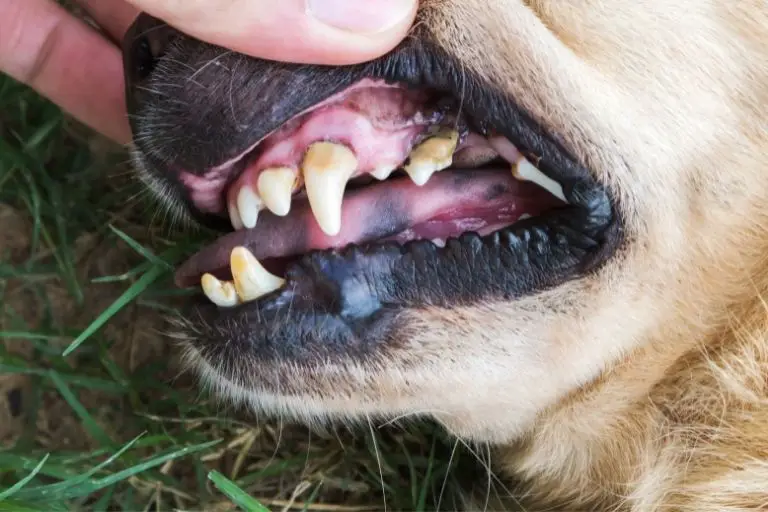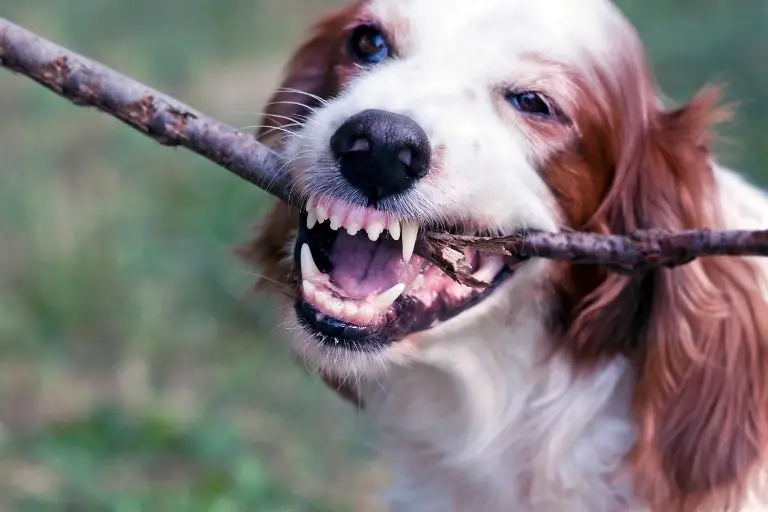Your dog’s smile is part of their charm, one of their many endearing traits. Oral health has a profound effect on your dog’s happiness. Crucial for their well-being is removing mouth plaque.
If you don’t, oral bacteria become rampant. In turn, they breed nasty infections, making your precious dog miserable.
Thankfully, it’s easy to remove plaque on a dog’s teeth. Plus, you can make the activity fun for your pup! Here’s how to maintain your dog’s pearly whites.
Table of Contents
- What comprises plaque?
- Is plaque bad for dogs?
- How do I get plaque off my dog’s teeth?
- How can I remove persistent tartar?
- Are certain breeds more prone to dental issues?
- What is the best tartar remover for dogs?
- What about dogs in poor health?
- Grateful Kisses
- FAQs
What comprises plaque?
Plaque is a byproduct of your dog’s saliva, oral bacteria, and food residues. When combined, they form a sticky coating on your dog’s teeth and gums. Plaque is colourless to pale yellow, arising within a few hours of eating.
Is plaque bad for dogs?
Plaque sets the stage for many diseases. Thus, you’ll want to expel it daily. Otherwise, the calcium in your dog’s saliva mixes with plaque, hardening it. Such calcium deposits are called tooth tartar, a yellow or brown crust, pictured here.
When ignored, the tartar on a dog’s teeth invades their gums. Since bacteria feed on both plaque and tartar, they flourish, endangering a dog’s health body-wide.
What medical problems result from plaque and tartar?
Below are five associated ailments, along with how to spot them.

Gingivitis
Your dog’s gums are inflamed, evidenced by swelling, redness, and bleeding. The resulting soreness makes chewing painful. How can you tell? One sign is your pup trying to eat but dropping the food from its mouth. Meanwhile, if your dog kisses you, their bad breath makes you wince.
Periodontal Disease
Bacteria overtake the gums. Now, they weaken the tissues and bone supporting your dog’s teeth. Symptoms include gum pockets, yellow pus, loosening teeth, and tooth loss.
Furthermore, tartar buildup separates the gums from your dog’s teeth, exposing the roots. Thus, chewing is agonizing. Consequently, your dog won’t eat, becoming listless and losing weight.
Dental Abscess
This is a pocket of infection pervading a tooth or gum tissue, appearing as a bump. As the condition worsens, the bump may ooze green, yellow, or bloody pus. Your dog may refuse to eat, spending much of the day napping. Additionally, your pup may cringe when you pet its head, prompted by mouth pain.
Cavities
The bacteria in plaque produce acids, adhering to your dog’s teeth. The acids erode their tooth enamel, the hard shell protecting the tooth surfaces. By this, plaque causes tooth holes called cavities.
Remote Infections
The bacteria camped in plaque and tartar can enter your dog’s bloodstream. From there, they can harm your dog’s vital organs, such as their kidneys, liver, and heart.

How do I get plaque off my dog’s teeth?
1. Tooth Brushing
Vets recommend a daily practice of brushing your dog’s teeth, beginning at age six months. It’s best to form this habit by degrees, giving your pup time to adapt.
Before using a toothbrush, you’ll clean your dog’s mouth with your finger. This way, your pup acclimates to the feeling of rubbing against their gums and teeth.
Gearing Up
First, buy dog toothpaste. It comes in flavours canines love, such as beef and chicken. Never use human toothpaste! It can make your dog terribly ill. Fluoride, in particular, can be fatal for dogs.
Always choose a time for home dental care when your pup is relaxed and calm. With your supplies handy, take a friendly position, such as sitting before them or at their side.
Finger Swabbing
Squeeze some toothpaste onto your finger, letting your dog sample it. Then, reapply the paste to your second finger.
With the other hand, lift your dog’s upper lip. Using circular motions, gently rub your dog’s front teeth and gums with toothpaste. Include the gum line, where the gums touch the teeth. Bacteria collect there.
Is your pup anxious and restless? In that case, stop the training, putting the toothpaste away until tomorrow. Then, each day, spend a few seconds finger swabbing your dog’s mouth with toothpaste.
Gradually, with repetition, your pup should warm up to having their mouth cleaned. Toward this end, reward your dog after every session with healthy treats.
Enter, Toothbrush!
Once your dog accepts finger swabbing, introduce a dog toothbrush, perfectly angled for your dog’s teeth. Canine toothbrushes come in two styles. One designed for small-mouthed dogs is a finger brush.
If your dog is large, consider a long-handled toothbrush, shown here.
Apply toothpaste to the brush, letting your dog lick it. Then, reload the brush with paste. Raising your dog’s upper lip with one hand, brush the front teeth in small circles. Focus on the outer surfaces and gum line. As your dog licks their mouth, their coarse tongue will clean the inner teeth.
Does your pup shy away from you? If so, spend a few sessions letting them lick toothpaste from the brush. Then, try cleaning your dog’s front teeth again.
Initially, your dog may cooperate briefly, letting you brush for a few seconds. Still, that’s progress! Gradually, expand your radius to include your dog’s back teeth.
To coax your pup’s cooperation, speak to them affectionately. When finished, praise your dog profusely, awarding a few treats. Then, rinse the toothbrush well, letting it air-dry.
Here’s a video demo of the key points above, starring a sweet dog and his compassionate trainer.
Note: When you start a brushing routine, a little gum bleeding is likely. However, if you’re too zealous, heavy bleeding can result. If it doesn’t ease with a softer touch, your dog may have serious oral disease. In that case, make an appointment with your vet.
2. Dental Supplement
It’s best to augment tooth brushing with other defenses against bacteria. This way, you control the germs between tooth brushing sessions.
One option is using All Natural Plaque Clean, a powder sprinkled on your dog’s food. Its safe herbs and seaweed reduce bacteria, curbing plaque.
Meanwhile, its minerals arm your dog’s saliva against calcium deposits and tartar. Additional nutrients aid your pup’s digestive health, further targeting stinky breath.
With the included scoop, add the powder to your dog’s food daily. Over three to eight weeks, it starts softening and breaking up plaque and tartar. Gradually, your dog’s breath should smell fresher while their teeth become whiter. Here are customer reviews, including vet confirmation that the powder works.
Warning: If your pup has a thyroid condition, do not give All Natural Plaque Clean. The iodine it contains can interfere with thyroid medicines.
How can I remove persistent tartar?
1. Chew Toys
Give your dog rubber toys with bumpy surfaces. As your pup chews the toys, they’ll rub off surface tartar. You can even buy chew toys that dispense dog toothpaste!
Vets warn against offering bones, antlers, horse hooves, nylon toys, and ice cubes. Such hard objects can break your dog’s teeth. Worse yet, they can lodge in your dog’s throat, choking them.
2. Dental Dog Food
If your dog has oral disease, a vet may prescribe dental food and dental treats. Since they have a kibble-like texture, they rub plaque and tartar from your dog’s teeth.
Some products may contain anti-tartar additives, slowing plaque buildup. Still, they may have chemicals. That’s why I like All Natural Plaque Clean. Its ingredients are nutritious, effective, and safe.
3. Professional Cleaning
While peering inside your dog’s mouth, do you see trouble brewing? Examples are red gums, puffy tissues, an abscess, or broken teeth. Is their breath odor intolerable? If so, bring your dog to a vet for a thorough dental cleaning. As mentioned, longstanding tartar is stubborn, along with the bacteria it harbors. Together, they spawn body-wide infections and disease.
Preparation
The vet will examine your pup’s mouth, looking for signs of gum inflammation and infection. If your dog has an abscess or periodontal disease, the vet may prescribe antibiotics before the cleaning. The medicine will lower prevailing bacterial counts. Antibiotics can also protect a dog with poor immunity and weak vital organs.
Additionally, the doctor will perform blood testing, a clue to your dog’s overall health.
Procedure
The vet gives your dog anesthesia, enabling a thorough evaluation and painless care. Pressing gently, the doctor checks for loose teeth. X-rays will reveal any underlying tooth or bone damage.
Next, the doctor performs “dental scaling.” Ultrasonic tools banish tartar/plaque buildup, including that beneath the gum line. Even with daily tooth brushing, it’s tough to eliminate subsurface tartar.
Additionally, the doctor treats any oral infection. If your dog has loose teeth, the vet determines if they can be saved surgically. Lastly, your dog’s teeth are polished, restoring their innate gleam.
Aftercare
Since a professional cleaning dislodges bacteria, they can enter your dog’s bloodstream. Thus, the vet will prescribe antibiotics, protecting your pup from subsequent infection.
Once the sedation wears off, you can take your dog home the same day. Initially, they’ll be dazed from the anesthesia. Thus, reserve a quiet, comfy spot in your home where your pup can rest.
To avoid life-threatening dental issues, vets recommend professional teeth cleaning once a year.
Are certain breeds more prone to dental issues?
Tartar is prevalent in short-nosed breeds with flat faces. This problem stems from the misalignment of their jaw and teeth. Hence, while chewing toys and dental treats, tartar doesn’t budge.
Plus, small breeds have tiny mouths, causing overcrowded teeth. In that case, bacteria gain a stronghold, brewing mouth-loads of plaque.
Thus, vets advise that tooth brushing is vital for small-breed dogs.
What is the best tartar remover for dogs?
It depends on the extent of tartar. Mild buildup may yield to a dental supplement, chew toys, dental food, and dental treats. To remove tenacious tartar, the best course of action is professional cleaning by a vet.
Is your dog a senior? Even then, vets prefer to remove ingrained tartar, provided a dog has no conflicting medical problems.
“But isn’t anesthesia risky for older dogs?” you ask. Yes, it is. Still, vets can minimize sedation risk with certain medicines, enabling a lower anesthetic dose. Moreover, doctors closely monitor senior dogs with high-tech equipment. They also give stabilizing intravenous fluids.
If you’re nervous about professional cleaning, raise all your concerns with a vet you trust. This informative article can also guide your decision.
What about dogs in poor health?
If a dog is frail or has a risky medical condition, a vet may advise against professional cleaning. In that case, you can battle tartar with:
- All Natural Plaque Clean dental supplement
- chew toys, including those dispensing toothpaste
- prescription dental food and dental treats
Note that dental wipes for mouth swabbing are less effective. They come in cloths and pads, having chemicals that reduce bacteria and break down calcium. Still, you can’t remove the plaque lurking in tight spaces, such as between your dog’s teeth.
All Natural Plaque Clean gets into those crevices. Does your dog have a scant appetite? If so, this product is certainly worth a try. Customers say their pets love the flavour. Thus, it may even entice your dog to eat!
Grateful Kisses
Plaque is a gluey film on your dog’s teeth, colourless to light yellow. It’s a chemical reaction between your dog’s oral bacteria, saliva, and food remnants. Each time your dog eats, plaque appears within a few hours. If it parks there for more than a day, it morphs into crusty yellow or brown tartar.
Bacteria thrive on both plaque and tartar, brewing:
- gum redness, swelling, bleeding, and pain
- infections, including dental abscesses
- tooth weakening and tooth loss
- diseases of the kidneys, liver, and heart valves
To fend off bacteria, plaque, and tartar, try to brush your dog’s teeth daily with canine toothpaste. Since plaque turns into tartar quickly, boost your dog’s defenses with chew toys and All Natural Plaque Clean.
If your dog has an oral disease, bring them to your vet. The doctor will devise a treatment plan, possibly including professional dental cleaning. The vet may also prescribe dental food and dental treats.
All your efforts will help your dog, keeping their mouth clean and healthy. In turn, they’ll charm you with adoring smiles and lots of grateful kisses.
FAQs
Regular brushing is one of the most effective ways to prevent plaque buildup. There are also dental chews and treats designed to promote oral health by reducing plaque and tartar buildup. Some toys are designed to help clean your dog’s teeth as they chew.
Offering raw, meaty bones under supervision can help mechanically remove tartar. Some pet owners brush their dog’s teeth with coconut oil, which may have antibacterial properties. Owners also add a small amount of diluted apple cider vinegar to their dog’s water.






